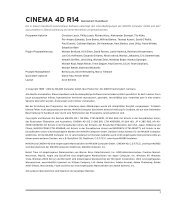Optional module - Maxon Computer
Optional module - Maxon Computer
Optional module - Maxon Computer
You also want an ePaper? Increase the reach of your titles
YUMPU automatically turns print PDFs into web optimized ePapers that Google loves.
148 CINEMA 4D R11 Quickstart – Dynamics<br />
If we play the animation now we will have a similar situation to the one we had in the previous chapter: The<br />
polygon object will fall out of the picture. We must set a zero value for the mass. But where? We will use the<br />
“Set Soft Mass“ from the “Dynamics“ menu. We will set the mass value of a point on the torus to “0“ which<br />
will keep this point in place (since it will possess no virtual weight) and the rest of the torus will follow the laws<br />
of gravity.<br />
To do this, select one or more of the top points of the torus in the point mode and select Dynamics / set soft<br />
mass. Change the mass value to 0 and click on “OK“.<br />
Finally, change the integration method of the solver object from “Adaptive“ to “Softbody“ and start the<br />
animation again.<br />
We’re done! The torus has a virtual hook and swings to and fro when you push it.<br />
There’s not much we can say about the state of the physics of the polygon body but we can say a little about its<br />
physical state. The torus has assumed the properties of a rubber-like mass and will behave according to gravity<br />
and the properties we gave it. In the second part of this tutorial we only showed one of the many possibilities<br />
soft body makes possible. The variations are virtually limitless. Now we’ll come to the part that will improve<br />
your workflow.<br />
6. Tips & Tricks<br />
Always set the editor’s frame rate to “All Frames“ (Animation / Frame Rate / All Frames). This function makes<br />
sure that every image of the Dynamics simulation will be visible and none will be suppressed since CINEMA 4D<br />
tries to adhere to the predefined amount of frames.<br />
Depending on their complexity, Dynamics simulations can take very long to calculate and can place high<br />
demands on our CPUs. There are a couple of methods to achieve the same result without forgoing the smooth<br />
depiction in the editor window. A smooth depiction can save a lot of time in the “testing phase“.<br />
It’s better if you use less-complex polygon objects and define them as sub-objects of a HyperNURBS object. In<br />
most cases the result will remain the same. The simulation of the soft body springs, for example, will be much<br />
more fluid since only a few springs will be used in the Dynamics simulation.<br />
Bake the Dynamics simulation. This will transform the simulation into keyframes which has the major advantage<br />
that it will be depicted much smoother in your editor window and you can intervene and move or delete<br />
keyframes or even completely change a part of your simulation as you desire.<br />
You can also use negative collision fields instead of collision. This method is calculated faster and delivers the<br />
same result in most cases. Try the settings “Ellipsoid“ or “Box“ and see how they change your simulation. These<br />
settings are faster and often deliver the same result here as well.<br />
If your objects still pass through the plane simply increase the oversampling rate of the solver object. A value of<br />
4, for example, means that Dynamics will calculate four additional images between each frame. An oversampling<br />
rate of 8 will result in twice the amount of images between frames, and so on. The higher the value, the higher<br />
the probability a collision will be calculated correctly. Of course the frame rate will suffer with each increase<br />
in oversampling.









